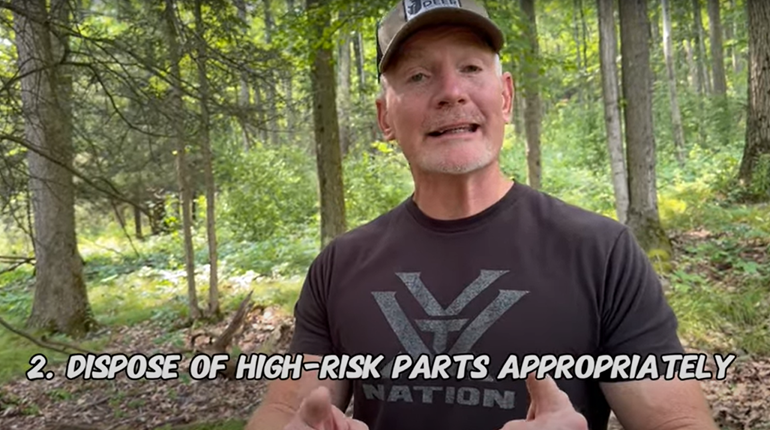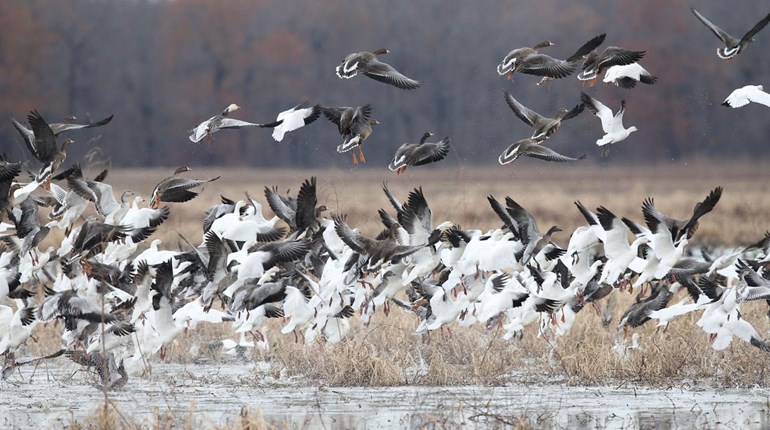
Lead photo courtesy of Dr. Terry Kreeger, Wyoming Game and Fish Department.
Chronic wasting disease (CWD) has been stalking the North American continent for at least the last 50 years. The first identified case of CWD in the U.S. was a captive mule deer in Colorado in 1967. Then in 1981, also in Colorado, the first free-ranging elk tested positive for the fatal disease. By 2000, the testing of hunter-harvested deer detected CWD in southwestern Nebraska, and by 2001 a free-ranging deer in South Dakota was found to be CWD positive. Later that same year, Wisconsin learned CWD had made it past the Mississippi River and into their borders, and by 2002, on the other end of the continent, an emaciated free-ranging mule deer in New Mexico tested positive for the dreaded disease.
Since 2006, when the first discovery of the disease was made, West Virginia has been continually expanding their CWD-endemic area. The area began at 15 square miles and by 2013 crept its way up to 108 square miles. Then this year, Michigan tested their first positive free-ranging deer; their first CWD positive deer was captive and found in 2008. So, what is this disease? Why is it so rampantly spreading across the U.S.? And is there hope for a cure anytime soon?

Chronic wasting disease is classified as a transmissible spongiform encephalopathy (TSE), or prion disease, and has been found in most deer species such as elk, moose, mule and white-tailed deer. Let’s break down the name and meaning of this disorder. A prion is a single protein that’s much smaller than bacteria and is very difficult to “kill” because it doesn’t respond to ultraviolet light or extreme heat. An encephalopathy is any disease that alters the function or structure of the brain. The prions in TSE cause the degeneration of the brain affecting its ability to operate properly. So, CWD is an infectious (transmissible) brain disease (encephalopathy) that causes porous degeneration, similar to a sponge, (spongiform) of the brain, and currently scientists are unsure of how to “kill” these causative agents (prions). Symptoms of CWD are emaciation, abnormal behavior, loss of bodily functions, excessive salivation (or drooling), head tremors and death.
The insidious prions of CWD are baffling scientists, but what they do know is that their resilience is surprising. Through saliva, feces, urine, blood and decomposing corpses, infected prions can enter the soil and can remain viable for at least two years. In 1985 the Colorado Division of Wildlife attempted to eliminate CWD from a contaminated facility. They treated the soil with chlorine, removed that treated soil, then applied another chlorine treatment to the remaining soil and let the facility remain vacant for more than a year. The results? Despite the excessive attempts to eliminate CWD from the facility, the treatments proved to be unsuccessful and the soil still tested positive for the prion disease.

Now, what does CWD mean to hunters or farm owners in CWD endemic areas? Is this TSE able to infect other mammals it’s not naturally hosted by, meaning people and livestock? Well with CWD’s close association to bovine spongiform encephalopathy (BSE), which is much more commonly known as “mad cow disease,” there’s reason to cautious. In 1996, the British government announced that BSE could be transmitted to humans, but only after three people died of variant Creutzfeldt-Jakob disease (vCJD) the previous year. A strong link between vCJD, a very rare and fatal neurodegenerative disease, and BSE make the association likely. Yet, in the early 1990s, after BSE had first been diagnosed about four years prior, the British government stated that the disease presented no harm to humans. Presently the Chronic Wasting Disease Alliance told Food Safety News that there is no solid evidence that humans can be infected with the disease from deer, elk or moose, stating that BSE (mad cow disease) and CWD are “distinctly different.” The World Health Organization also stated that there was no clear evidence that CWD can be passed on to humans. Yet, despite the current lack of evidence, the Chronic Wasting Disease Alliance does recommend avoiding exposure to CWD infected deer and meat, because those who fail to learn from history are doomed to repeat it, and who knows what could come of this disease in future years.

CWD does not appear to occur naturally outside the deer species, and still there are concerns about the possibility of CWD transmission to livestock, such as cattle and sheep, through contact with contaminated environments. If there is a plus side to this fatal disease it’s this: Ongoing experimental studies, surpassing six years of observation, show that CWD has not been transmissible to cattle. Researchers orally administered the CWD agent to 11 cattle and kept 24 cattle to live with a herd of CWD-infected deer; and none of the cattle developed the prion disease.
To date, at least 22 states and two Canadian provinces have verified CWD in either free-ranging or captive deer, or both, and there is no known cure for the disease. Thankfully there are recommendations for citizens in a CWD-affected area, or for those who want to take extra precautions. Follow the suggestions below to help keep you and your family safe, and to assist your state in the tracking of the disease:
- Have all of your hunting-harvested meat tested for CWD, and other diseases; bring all deer, elk and moose to check stations.
- Report any deer killed by a collision with a motor vehicle, and do not salvage the deer. Research has shown that CWD-infected deer are more likely to be involved in vehicular accidents due to the symptoms of the disease.
- If you hunt in a CWD-positive area, do not continue any elk and deer feeding and baiting, as this brings many deer to one area which can help the disease to spread further.
- Report any emaciated or unusually thin deer.
- Report unusual behavior of deer, like allowing humans to approach or excessive drooling

Be sure to make your report to your state’s division of natural resources, or contact your state government to find the correct department.
This disease is a real threat to what’s arguably America’s best-loved game animal. The disease has already proven its resilience, but those long hours crouched behind a blind, patiently waiting in a tree-stand, hauling pounds of meat for miles and miles, and everything else that makes hunting a test of determination, shows that hunters may have more resilience than CWD.
References for article:
-Belay, E.D., et al. Chronic Wasting Disease and Potential Transmission to Humans. Emerging Infectious Diseases, 2004. www.cdc.gov
-Beecher, Cookson. ‘Surprising’ Discovery Made About Chronic Wasting Disease. Food Safety News. 2015. www.foodsafetynews.com
-Ross, Matt. CWD Prevalence Increasing in Wisconsin, Wyoming and West Virginia. Quality Deer Management Association. 2014. www.qdma.com.
-McCoy, John. Chronic Wasting Disease Spreads in W.Va. Charleston Gazette-Mail. 2014. www.wvgazettemail.com
-Chronic Wasting Disease Alliance. Michigan: Michigan confirms state’s first case of chronic wasting disease in free-ranging white-tailed deer. 2015. www.cwd-info.org
-Pritzkow, S. et al., Grass Plants Bind, Retain, Uptake and Transport Infectious Prions. Cell Rep. 2015. www.cell.com
-Center for Disease Control. Prion Diseases. 2015. www.cdc.gov.







































